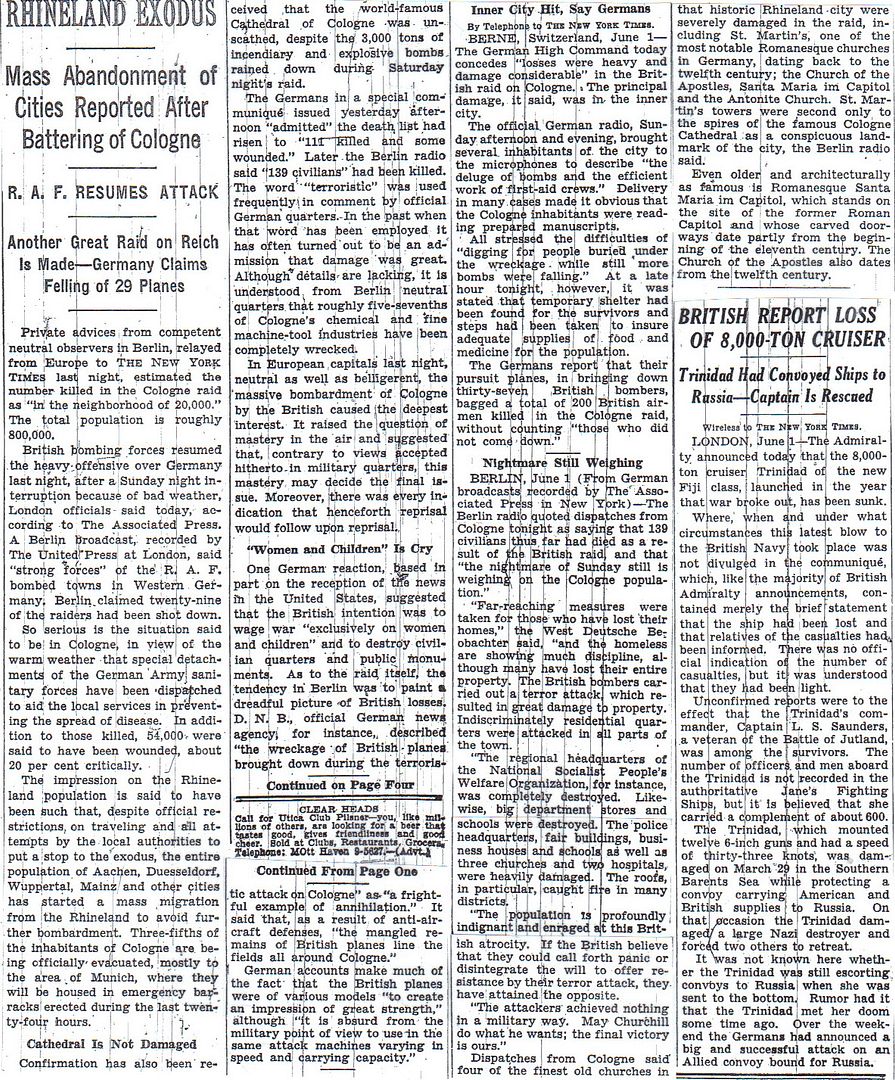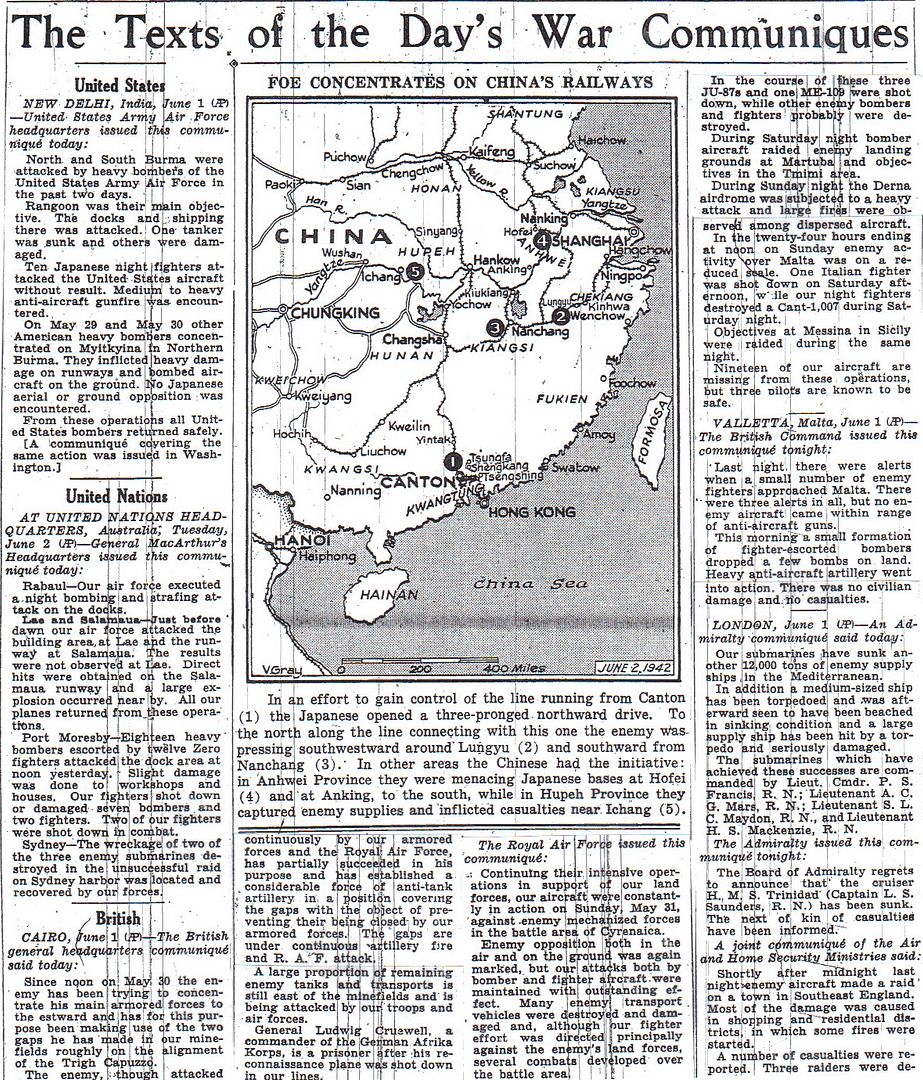
Posted on 06/02/2012 5:17:55 AM PDT by Homer_J_Simpson










* Rommel's chief of staff claimed that the box contained 1,200 separate positions and strong point.
The West Point Military History Series, Thomas E. Griess, Editor, The Second World War: Europe and the Mediterranean
http://www.onwar.com/chrono/1942/jun42/f02jun42.htm
Germans bombard Sevastopol
Tuesday, June 2, 1942 www.onwar.com
On the Eastern Front... The German bombardment of Sevastopol is renewed. German artillery gathered for the effort is comprised of 1300 guns, including the two 60cm “Karl” mortars and the 80cm “Dora” railway gun. The attack is supported by 7th Air Corps.
In North Africa... Battle of Bir Hacheim. The German 90th Light Infantry Division and the Italian Trieste Division, move south to take Bir Hacheim and free their flank. The units of Free French defending here continue to hold even after the 15th Panzer Division and heavy artillery is brought to bear.
In the Pacific... The US carriers from Pearl Harbor join northeast of Midway. In total, the American force has approximately 250 planes, equal to the number in the approaching Japanese force.
From the United States... US Secretary of State Hull and Chinese Foreign Minister Soong sign a Lend-Lease agreement.
In the Aleutian Islands... Japanese Admiral Katuta’s light carrier force attacks Dutch Harbor as a diversion. The Americans, aware of the Japanese plans for the invasion of Midway do not react as predicted.
Thank you for this post. My father and Aunt Mary were children in these bombings.
http://homepage.ntlworld.com/andrew.etherington/frame.htm
June 2nd, 1942
GERMANY: RAF Bomber Command has made its second 1,000-bomber raid in three nights, following up the smashing raid on Cologne with another on Essen last night. Essen the home of the Krupp arms works, is the industrial centre of the Ruhr and the heart of a great network of railways linking the Westphalian iron and coal fields. Thick cloud and industrial haze over the target hampered the bombers and few crews could pinpoint their targets, but Mr. Churchill told the House of Commons today that they had caused “numerous and widespread conflagrations.” The captain of a Lancaster said of the raid: “To those of us who had been over the Ruhr before it seemed a pretty good smack at the place. Not a great blaze like Cologne, but in the industrial region of Essen there were really large fires when I left for home.”
Diversionary attacks were mounted by Blenheims of Army Cooperation Command while Beaufighters flew intruder missions against German night fighters. Out of the 956 aircraft which took part in the raids, 31 are missing.
U.S.S.R.: German forces renew the bombing and launch an artillery barrage to weaken the defences of Sevastopol.
MEDITERRANEAN SEA: U-652 (Type VIIC) badly damaged by depth charges from a British Swordfish aircraft and scuttled on 2 June, 1942 in the Mediterranean in the Gulf of Solum, at position 31.55N, 25.113E, by torpedoes from U-81. (Dave Shirlaw)
NORTH AFRICA: Rommel’s 90th Light and Trieste Divisions move to Bir Hacheim to cover his flank. The Free French hold against the 15th Panzer Division.
U-652 (Type VIIC) Badly damaged by depth charges from a British Swordfish aircraft and scuttled in the Mediterranean in the Gulf of Solum, at position 31.55N, 25.113E, by torpedoes from U-81. (Alex Gordon)
MADAGASCAR: After reports from locals that two Japanese had been seen in the Amponkarana Bay area, they were eventually found by a British patrol of 15 soldiers. These are the crew of the Japanese midget submarine crew that had attacked the HMS Ramillies on May 30. They would not surrender, as honour dictated, and fought with pistols and a sword.
They killed one British soldier and wounded four others before they themselves were killed. The crew’s documents were recovered and these included details of their mission in the harbour. The wreckage of their midget submarine was located some time later by a British air reconnaissance aircraft.
The crew of the miniature submarine from I-16 also failed to return from their mission and a search party on the beach outside the harbour found the body of another Japanese in Naval uniform the day after the attack. Their miniature submarine and the second crewmember were never found and the Japanese Navy will post both miniature submarines as missing tomorrow. (Denis Peck)
PACIFIC OCEAN: US Carrier Task Forces meet north-east of Midway Island.
Task Force 17 (TF-17) under Rear Admiral Frank Jack Fletcher and Task Force 16 under Rear Admiral Raymond A. Spruance, rendezvous about 350-miles (648 km) northeast of Midway Island. The joint force, under tactical command of Admiral Fletcher, is composed of three aircraft carriers, seven heavy cruisers, one light cruiser, 16 destroyers and two oilers. Supporting are 25 submarines deployed around Midway.
Six of the 16 B-17E Flying Fortresses that have been on detached service at Midway Island return to Oahu, Territory of Hawaii. (Jack McKillop)
TERRITORY OF ALASKA:
Japanese Admiral Kakuta’s light carriers prepare to aid Dutch Harbor in the Aleutian Islands as part of the deception for the Midway Operation.
Two PBY-5A Catalinas of the USN’s Patrol Squadron Forty One (VP-41) based at Naval Air Station (NAS) Dutch Harbor, Alaska, locate the Japanese aircraft carriers HIJMS Ryujo and HIJMS Junyo approximately 210 miles (644 km) from Dutch Harbor. Both PBYs are shot down after reporting the position of the ships; all crewmen perish except one who is taken prisoner.
U.S.A.: Washington: Chinese Foreign Minister Soong and US Secretary of State Hull sign Lend-Lease Agreement.
Jazz/swing trumpeter Bunny Berigan dies in New York City from the effects of alcoholism. He was 33-years-old. Born in 1908, he began playing professionally in 1921 and continued playing in Wisconsin throughout the 1920s. He played briefly in New York and Philadelphia in 1926 and returned to New York again in 1929 where he joined Hal Kemp’s band in the spring of 1930 and went to Europe with the Kemp Band. Returning to New York, he freelanced and did extensive studio work with various bands. In 1932, he worked in the Dorsey Brothers’ Band for the Broadway show “Everybody Welcome” and then joined the Paul Whiteman Orchestra from late 1932 to late 1933. Until 1937, he did studio work and worked with various bands, e.g., the Dorseys, Benny Goodman, Red Norvo, Ray Noble, etc. In the spring of 1937, he formed his own big band and he led it until going bankrupt in the spring of 1940. Between March and August 1940, he played with Tommy Dorsey’s Band and then formed his own small band for residency at the 47 Club in New York until forming another big band in 1941; this latter band recorded part of the soundtrack for the RKO film “Syncopation” but Berigan was so drunk most of the time that someone else had to complete the soundtrack. Berigan returned to New York City with his band until hospitalized with pneumonia in April 1942. He left the hospital on 8 May and continued playing until 30 May when he suffered a severe hemorrhage and died at New York Polyclinic Hospital. His best-known records, are “I Can’t Get Started;” “King Porter Stomp “ with Benny Goodman; and “Marie,” “Who” and “Song of India,” recorded with Tommy Dorsey. (Thanks to Matt Clark for providing the above mini bio.)
The air echelons of the four squadrons of the USAAF’s 97th Bombardment Group (Heavy), equipped with B-17Es and preparing to deploy to the U.K, are ordered to bases on the U.S. west coast as a defensive measure against Japanese attack. (Jack McKillop)
MEXICO: Mexico declared war on Germany after two Mexican tankers had been sunk by U-boats - Potrero del Llano on 14 May by U-564 and Faja de Oro on 21 May by U-106. (Dave Shirlaw)
ATLANTIC OCEAN: The German submarine U-159 sinks an unarmed U.S. merchant freighter about 400 miles (741 km) northeast of San Juan, Puerto Rico.
(Jack McKillop)
"Besides shootings and gassings, the Nazis also killed Jews through natural means: slowly starving them to death.
In ghettos such as Warsaw, Jews received food rations that were a fraction of normal requirements.
Children and the elderly perished first.
Bloated corpses littering streets became commonplace.
"In the Lódz (Poland) Ghetto, journalist Joseph Zelikowicz witnessed thousands of people dragging themselves through streets, rummaging through piles of garbage to find 'a piece of broken pot that can still be licked, or a rag that once wrapped food and can still be gnawed at.'
"Zelikowicz described bodies distorted by starvation, with 'flabby stomachs, sunken breasts, hollows around their necks,' and legs so badly swollen that 'if you stick a finger in such a leg, you leave an impression, a sallow gray spot, as in half-baked bread.'
"In concentration camps, inmates also suffered starvation but were additionally forced to work to the point of exhaustion.
Utterly desperate for food, prisoners in some camps even ate grass.
Many became skeletal figures with dry, ashen skin, their cheekbones almost protruding, with elongated heads.
Most also suffered from extreme, dehydrating diarrhea.
Totally apathetic to life, for many relief came only through death."
Disclaimer: Opinions posted on Free Republic are those of the individual posters and do not necessarily represent the opinion of Free Republic or its management. All materials posted herein are protected by copyright law and the exemption for fair use of copyrighted works.